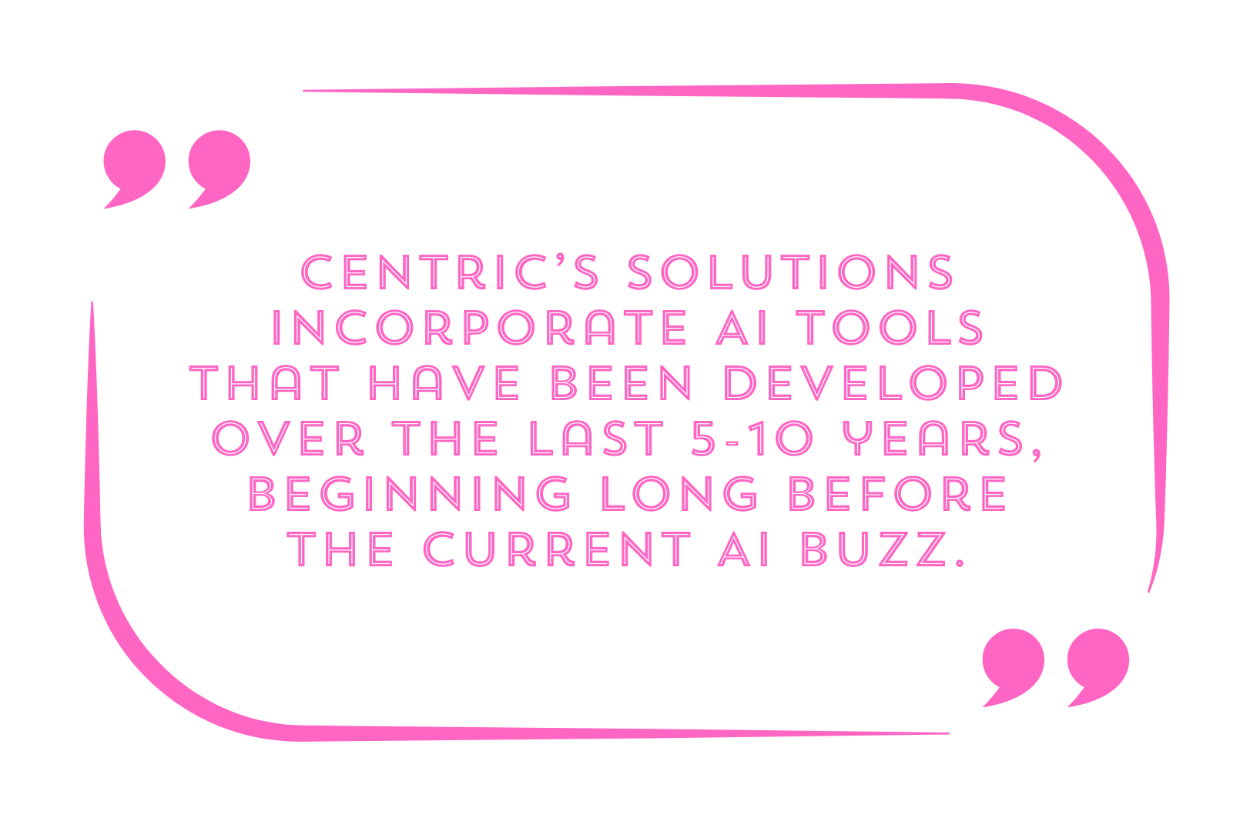Released in The Interline’s AI Report 2024, this executive interview with Centric Software is one of a fourteen-part series that sees The Interline quiz executives from companies who have either introduced new AI solutions or added meaningful new AI capabilities into their existing platforms.
For more on artificial intelligence in fashion, download the full AI Report 2023 completely free of charge and ungated.
Key Takeaways:
- Centric Software leverages AI to optimize decision-making and enhance efficiency across the fashion and retail industries, focusing on solving specific business challenges with precise alignment to customer needs rather than offering one-size-fits-all solutions.
- AI is integrated throughout Centric’s product lifecycle, from pre-season planning to post-season analysis, delivering measurable ROI by improving margins, reducing time to market, and enhancing productivity.
What’s your working definition of AI? Does it differ from the public understanding, which is currently dominated by large language models and generative text-to-image models? And how does that definition manifest itself in your solution(s) and services for fashion?
At Centric Software, our definition of AI includes decision support and at-scale decision execution automation enabled by multiple types of AI and Machine Learning (ML) as well as knowledge management. Centric AI use cases are market-driven by our Customer Advisory Board and innovation partners to support their business strategies and business process driven scenarios with an eye towards usability, transparency, explainability and control.
We see AI as another option in the toolbox of problem-solving technologies for our customers. Throwing AI at a problem is not a solution in itself. If you don’t have the right training data, if you let AI operate without sufficient human-assisted guardrails, or if you don’t have the right expertise to apply it properly with business adoption change management considerations in mind, it won’t live up to its potential. Data is a particularly crucial element of this. An algorithm can be set up to address the problem you are trying to solve – such as coming up with an ideal price point for a product. But if you don’t feed it with enough accurate, up-to-date data with the right contextual nuances, AI will generate less than ideal, even wrong, results. For supervised learning, humans need to guide the process and monitor the outcomes of machine learning until the algorithm has learned enough to take over some functions, and then manage by exception.
Centric’s solutions incorporate AI tools that have been developed over the last 5-10 years, beginning long before the current AI buzz. We have assembled a team of global industry experts that understand exactly how to apply AI to solve specific challenges, rather than offering a one-size-fits-all solution. Just as our development of PLM has been guided by the process dynamics and data management patterns intrinsic to the fashion and FMCG industry, our strategy for AI solutions emphasizes the need to align with the various ways our customers work in a surgical manner as we seek to bring transformative benefits.
We see AI as a crucial part of a ‘right aisle’ (as opposed to ‘endless aisle’) retail strategy that aims to only develop and bring to market products that consumers really want, rather than offering broad assortments that have ‘something for everyone’; the need to optimize revenue, margins, brand identity and the like remain paramount.
Our AI tools are designed to discover and take into account ‘influence factors’ that affect decisions such as pricing, product and assortment management. These might be anomalies in historical data due to one-off disruptions (think pandemic sales figures, for instance), or seasonal pricing fluctuations. With over 20 years of expertise in fashion and retail, we know what those influence factors are and how they can distort the picture, and how to tease them out through the rigor of a data science methodology. These factors have to be built into AI algorithms in order to give your teams an accurate reflection of what has happened in the past (with context), and how best to proceed in the future, with transparent rationalization of decisions and recommendations that inspire confidence and accelerate adoption.

You mentioned a need there for precise alignment between customers’ specific challenges and applications of AI. Do brands and retailers have a clear idea of what they want to use AI to achieve today, or more of a general vision for what they’d like to accomplish in the future?
The problems our customers want to solve with AI are the problems that fashion and retail businesses struggle with in general. Overstocking; poor sales; slow time to market; loss of margins due to discounting; pricing competitively; optimizing assortments; getting inventory to the right place at the right time…these are all common challenges for fashion brands and retailers.
Our focus is on our customer base and their processes first, with AI as a means to an end. We work hand-in-hand with our customers to examine these problems and figure out how technology can be best applied in each scenario. Rather than saying ‘AI can fix this’, we ask whether AI has a role in fixing this, and how. In addition, we have to also consider customer adoption challenges (e.g. adoption resistance) and incorporate method steps that validate and inspire confidence in the recommendations made by AI as well as the overall business results.
Given that Centric has a lot of different pieces in its portfolio of solutions, all arrayed in a way that’s intended to address the different go-to-market processes as a single workflow, how have you approached integrating AI into that journey? Do you look at it as something with broad applicability (and broad ROI potential) across the entire lifecycle, or are the use cases narrower and more focused?
AI has a role to play from pre-season planning, to in-season execution, to post-season analysis. We infuse AI into many stages of the product lifecycle, using AI at specific points in the process where it can do more for decision-making, analysis and execution than teams can do using other technologies and manual systems, especially when scale effects are prevalent. AI can detect patterns that humans cannot see, crunch numbers in vast amounts of data, and pull together historical, current and future-focused (e.g. customer intent) data to make suggestions.
There needs to be a measurable impact if you decide to invest in AI. We don’t encourage customers to use AI just for the sake of using the newest, hottest thing. Very few AI technologies have shown hard ROI to-date.
AI has been incorporated into our market-leading PLM solution in the form of material compatibility driven product structure (BOM) validation and image search tools for many years, and delivers ROI for customers through all of our solutions, including:
- Centric Planning™ is an innovative, cloud-native, AI solution delivering end-to-end planning capabilities to maximize retail and wholesale business performance resulting in a 110% increase in margin.
- Centric Pricing & Inventory™ leverages AI to drive margins and boost revenues by up to 18% via price and inventory optimization from pre-season to in-season to season completion.
- Centric Market Intelligence™ is an AI-driven platform giving insights into consumer trends, competitor offers and pricing to boost competitivity and get closer to the consumer, with a proven 12% increase in average initial price point.
- Centric PLM: takes advantage of AI in several ways and globally delivers a dramatic reduction in time to market by up to 60%, reduced COGS by up to 15% and improved productivity by up to 50%.
With AI being positioned as the start of a new wave of enterprise technology, a lot of organisations are thinking deeply about their technology ecosystems in general, and how ready the different pieces are for a future that could look very different. In that context, what do you believe makes Centric stand out as a futureproof partner in AI and beyond?
Centric is distinguished from competitors by our decades of fashion and retail experience and commitment to customer success, encapsulated in our ‘Best Customers, Best Solutions, Best Team’ ethos. We’re also unique in our delivery of solutions using Centric’s Agile DeploymentSM methodology that cuts right through pre-season, in-season and post-season processes, broadening the definition of Product Lifecycle Management far beyond its traditional development boundary to encompass sourcing, merchandise planning and pricing, stock and market trend analysis, for instance.
We’ve developed an end-to-end solution suite that connects the dots from product concept to sourcing right through to replenishment at retail. We’re very focused on creating integrated processes and seamless data flows that eliminate silos and barriers between teams. This relentless focus on seamless business concurrency and continuity, along with the ability to easily integrate Centric solutions with other business systems, is a true differentiator for our customers.

Our acquisition of AI-driven tools such as StyleSage (now Centric Market Intelligence) and aifora (now Centric Pricing & Inventory) have added immense value to our product offering. From enhanced competitive analysis to dynamic pricing and basket analysis, our customers are now able to make faster, more accurate and more profitable decisions with the assistance of AI.
We’re also strongly focused on the visual element of data. We recognize that teams need data to be represented in different ways and have developed highly visual collaborative tools that merge ‘left-brain’ and ‘right-brain’ orientations. Our solutions are data based, but visually presented; or presented in quantitative structures and formats for those who are more analytically oriented.
What do you see as the near-term future of AI – both within your solution(s) and services, and in general? Do you believe it will be a transformative class of technologies the way people expect?
In terms of our solutions, the near-term future for AI lies in capabilities that we already have in place – but we will be continuously refining and developing those in response to specific customer needs and priorities. Ultimately, we want to build more services around AI that meet our customer process requirements and enable them to be more creative, efficient, sustainable and profitable. It comes back to solving their biggest challenges. The FMCG domain lies at the heart of the Centric DNA, and we expect to pragmatically apply AI as we expand the continuity of processes and the coverage of use cases across our domain.
We have some very specific initiatives but of course are not at liberty to disclose them just yet!
Looking at the bigger picture, it’s easy to say that a class of technologies will be ‘transformative’ but harder to apply and accomplish than transformation in the context of a specific organization. A company has to have the wherewithal and motivation to go through that journey. However, we believe that AI has the potential to be transformative in that it makes it possible to ask very strategic questions and answer them at scale in a way that simply wouldn’t be possible with human brainpower alone because there are too many variables and too much information and dimensions to process. This can lead to changes in processes and strategy that you never anticipated, because the option wasn’t previously there. We do also believe that AI will lead to new job roles, new areas of expertise and new opportunities for people while also reducing non-value-added work and wasted time and relieving users of mundane activities, thus freeing them up to focus on more important things.
To really make transformation happen and realize the potential of AI, businesses need top-down leadership with bottom-up adoption. Any technology that you inject with that transformative mindset, whether AI-powered or otherwise, will fundamentally change the trajectory of your business.

